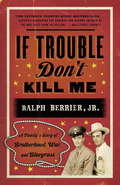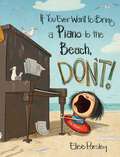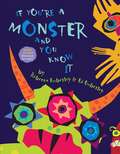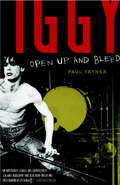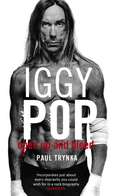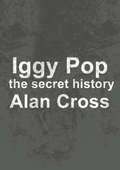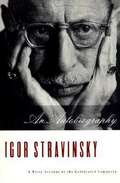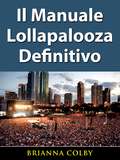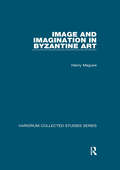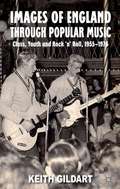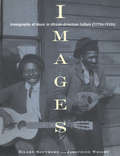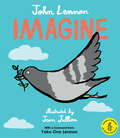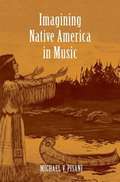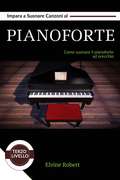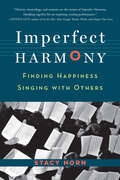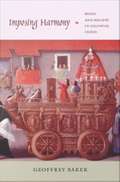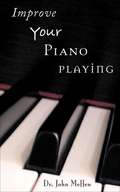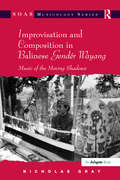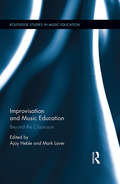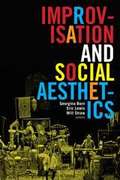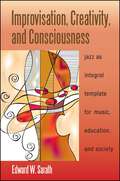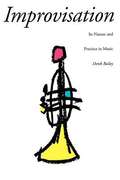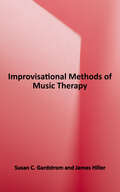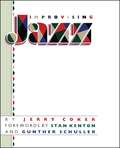- Table View
- List View
If Trouble Don’t Kill Me: A Family’s Story of Brotherhood, War, and Bluegrass
by Ralph Berrier Jr.Making moonshine, working blue-collar jobs, picking fights in bars, chasing women, and living hardscrabble lives ... Clayton and Saford Hall were born in the backwoods of Virginia in 1919, in a place known as The Hollow. Incredibly, they became legends in their day, rising from mountain-bred poverty to pickin' and yodelin' all over the airwaves of the South in the 1930s and 1940s, opening shows for the Carter Family, Roy Rogers, the Sons of the Pioneers, and even playing the most coveted stage of all: the Grand Ole Opry. They accomplished a lifetime's worth of achievements in less than five years-and left behind only a few records to document their existence. Fortunately, Ralph Berrier, Jr. , the grandson of Clayton Hall and a reporter for the Roanoke Times, brings us their full story for the first time in IF TROUBLE DON'T KILL ME. He documents how the twins' music spread like wildfire when they moved from The Hollow to Roanoke at age twenty, and how their popularity was inflamed by their onstage zaniness, their roguish offstage shenanigans, and, above all, their ability to play old-time country music. But just as they arrived on the brink of major fame, World War II dashed their dreams. Berrier follows the Hall twins as they travel overseas, leaving behind their beloved music, and are thrust into the cauldron of a war that reshaped their lives and destinies. Through the brothers' experiences, the story of World War II unfolds-Saford fought from the shores of North Africa to Sicily and Europe and finally into Germany; Clayton fought the Japanese in the brutal Pacific theater until the savage, final battle on Okinawa. They returned home after the war to find that the world had changed, music had changed . . . and they had, too. IF TROUBLE DON'T KILL ME paints a loving portrait of a vanishing yet exalted southern culture, shows us the devastating consequences of war, and allows us to experience the mountain voices that not only influenced the history of music but that also shaped the landscape of America.
If You Ever Want to Bring a Piano to the Beach, Don't!
by Elise ParsleyElise Parsley's tale of the charismatic and willful Magnolia's disastrous trip to the beach follows up her New York Times bestselling debut, If You Ever Want to Bring an Alligator to School, Don't! If your mom says to get ready to play at the beach, she means with a boat, or a Frisbee, or a shovel. She is NOT talking about the piano. But Magnolia is a little girl with a big idea, determination, and one very heavy upright piano that, she insists, she needs to take with her. What's the worst that can happen? In a riotous series of mishaps, Magnolia quickly learns that--not surprisingly--a piano doesn't mix well with sand, sun, and seagulls!
If You're a Monster and You Know It...
by Ed Emberley Rebecca EmberleyIf you're a monster and you know it, and you really want to show it, if you're a monster and you know it--snort and growl. SNORT. GROWL. Stomp your paws, twitch your tail, and wiggle and wriggle along--as only a monster can. Download the catchy tune, sung by Adrian Emberley, at www.scholastic.com/ifyoureamonsterandyouknowit.
Iggy Pop: Open Up and Bleed
by Paul Trynka"Fellow rock stars, casual members of the public, lords and media magnates, countless thousands of people will talk of their encounters with this driven, talented, indomitable creature, a man who has plumbed the depths of depravity, yet emerged with an indisputable nobility. Each of them will share an admiration and appreciation of the contradictions and ironies of his incredible life. Even so, they are unlikely to fully comprehend both the heights and the depths of his experience, for the extremes are simply beyond the realms of most people's understanding." --from the Prologue. The first full biography of one of rock 'n' roll's greatest pioneers and legendary wild men. Born James Newell Osterberg Jr., Iggy Pop transcended life in Ypsilanti, Michigan, to become a member of the punk band the Stooges, thereby earning the nickname "the Godfather of Punk." He is one of the most riveting and reckless performers in music history, with a commitment to his art that is perilously total. But his personal life was often a shambles, as he struggled with drug addiction, mental illness, and the ever-problematic question of commercial success in the music world. That he is even alive today, let alone performing with undiminished energy, is a wonder. The musical genres of punk, glam, and New Wave were all anticipated and profoundly influenced by his work.Paul Trynka, former editor of Mojo magazine, has spent much time with Iggy's childhood friends, lovers, and fellow musicians, gaining a profound understanding of the particular artistic culture of Ann Arbor, where Iggy and the Stooges were formed in the mid to late sixties. Trynka has conducted over 250 interviews, has traveled to Michigan, New York, California, London, and Berlin, and, in the course of the last decade or so at Mojo, has spoken to dozens of musicians who count Iggy as an influence. This has allowed him to depict, via real-life stories from members of bands like New Order and the Red Hot Chili Peppers, Iggy's huge influence on the music scene of the '70s, '80s, and '90s, as well as to portray in unprecedented detail Iggy's relationship with his enigmatic friend and mentor David Bowie. Trynka has also interviewed Iggy Pop himself at his home in Miami for this book. What emerges is a fascinating psychological study of a Jekyll/Hyde personality: the quietly charismatic, thoughtful, well-read Jim Osterberg hitched to the banshee creation and alter ego that is Iggy Pop.Iggy Pop: Open Up and Bleed is a truly definitive work--not just about Iggy Pop's life and music but also about the death of the hippie dream, the influence of drugs on human creativity, the nature of comradeship, and the depredations of fame.
Iggy Pop: The Biography
by Paul Trynka'For those who like their rock biogs thick with tales of heroic over-indulgence, OPEN UP AND BLEED is hard to beat' - Irish Evening Herald Iggy Pop's life has been one of extraordinary highs and terrifying lows. Infamous for his wild ways, he is also a towering figure of the rock scene - hugely influential, charismatic and provocative. Every 'mad, bad, dangerous to know' rock star owes a debt to him, and the stories of his shocking behaviour are legendary. But Iggy Pop is also, to a large extent, a construct, the alter ego of the quietly spoken and intriguing Jim Osterberg: the kid voted 'Most Likely to Succeed' by his classmates. So what turned this charming, well-mannered, straight-A student into a poster child for rock 'n' roll debauchery?Iggy Pop: Open up and Bleed reveals the truth behind the myths. Former MOJO editor Paul Trynka tracked down the star's friends, family, lovers and fellow musicians, conducting over two hundred and fifty interviews, unearthing countless new stories about Iggy's rollercoaster life, his music and his often misunderstood friendship with David Bowie. From this impeccable research he creates a fascinating portrait of a man at war with the world and with himself. The book also features dozens of never-before seen photos.
Iggy Pop: the secret history
by Alan CrossAlan Cross is the preeminent chronicler of popular music.Here he provides a history of punk icon Iggy Pop."The Godfather of Punk" looks at his career and is adapted from the audiobook of the same name.
Igor Stravinsky: An Autobiography
by Igor StravinskyWhile many hundred thousands of pages have been written about Stravinsky, in this book -- the composer's first -- we hear from the man himself. An Autobiography chronicles the first half-century of Stravinsky's life, all the while offering his opinions and "abhorrences". A Parsifal performance at Bayreuth? "At the end of a quarter of an hour I could bear no more". Nijinsky? "The poor boy knew nothing of music". Spanish folk music? "Endless preliminary chords of guitar playing".
Il Manuale Lollapalooza Definitivo
by Brianna ColbyChe tu sia nuovo o un veterano, questo manuale ha i consigli che ti serviranno per sopravvivere e vivere bene uno dei più meravigliosi festival di tutti i tempi! Il Loolapalooza continua ad essere una delle esperienze di festival più fantastiche che le persone abbiano mai fatto. Comunque ci sono molti consigli e trucchi che devi imparare per trarre il meglio da questa esperienza. Questo manuale ti insegnerà le cose da fare e non fare in questo festival, oltre a risparmiare denaro e divertirti allo stesso tempo! - Tipologie di biglietto & come risparmiare soldi - Risparmiare sui biglietti - Linee aeree e sconti - Alberghi e sconti - Come massimizzare la tua esperienza - Cosa portare e cosa lasciare a casa --> Vai in cima alla pagina e clicca su aggiungi al carrello per acquistare immediatamente Disclaimer: This author and or rights owner(s) make no claims, promises, or guarantees in regards to the accuracy, completeness, or adequacy of the contents of this book, and expressly disclaims liability for errors and omissions in the contents within. This product is for reference use only. Please consult a professional before taking action on any of the contents found within.
Image and Imagination in Byzantine Art (Variorum Collected Studies #866)
by Henry MaguireThe twelve studies contained in this second collection by Henry Maguire are linked together by a common theme, namely the relationship of Byzantine art to the imaginary. They show how art enabled the Byzantines not only to imagine the sacred events of the past, but also to visualize the invisible present by manifesting the spiritual world that they could not see. The articles are grouped around the following five topics: the depiction of nature by the Byzantines before and after iconoclasm, especially in portrayals of the earthly and the spiritual Paradise; the social functions and theological significance of classical artistic forms in Byzantine art after iconoclasm; the association between rhetoric and the visual arts in Byzantium, especially in contrast to the role played by liturgical drama in western medieval art; the relationship of the visual arts to Byzantine concepts of justice and the law, both human and divine; and portrayals of the two Byzantine courts, the imperial court on earth and the imagined court in heaven. The papers cover a wide range of media, including floor and wall mosaics, paintings in manuscripts and churches, ivory carvings, coins, and enamel work.
Images of England Through Popular Music: Class, Youth and Rock 'n' Roll, 1955-1976
by Keith GildartDrawing on archival sources and oral testimony, Keith Gildart examines the ways in which popular music played an important role in reflecting and shaping social identities and working-class cultures and - through a focus on rock 'n' roll, rhythm & blues, punk, mod subculture, and glam rock - created a sense of crisis in English society.
Images: Iconography of Music in African-American Culture (1770s-1920s) (Music In African American Culture Ser. #Vol. 1)
by Eileen J. Southern Josephine WrightThis lavishly illustrated book brings together for the first time a significant body of imagery devoted to the traditional culture of the African-American slave.
Imagine: Level 5 - Intermediate Showcase Solos Pop Sheet (Original Sheet Music Edition Ser.)
by John Lennon Jean JullienImagine all the people living life in peace. You may say I'm a dreamer, but I'm not the only one. I hope some day you'll join us, and the world will be as one. Join one little pigeon as she sets out on a journey to spread a message of tolerance around the world. Featuring the lyrics of John Lennon’s iconic song and illustrations by the award-winning artist Jean Jullien, this poignant and timely picture book dares to imagine a world at peace. Imagine will be published in partnership with human rights organization Amnesty International.
Imagining Native America in Music
by Michael V. PisaniThis book offers a comprehensive look at musical representations of native America from the precolonial past through the American West and up to the present. The discussion covers a wide range of topics, from the ballets of Lully in the court of Louis XIV to popular ballads of the nineteenth century; from eighteenth-century British-American theater to the musical theater of Irving Berlin; from chamber music by Dvoˆrák to film music for Apaches in Hollywood Westerns. Michael Pisani demonstrates how European colonists and their descendants were fascinated by the idea of race and ethnicity in music, and he examines how music contributed to the complex process of cultural mediation. Pisani reveals how certain themes and metaphors changed over the centuries and shows how much of this "Indian music," which was and continues to be largely imagined, alternately idealized and vilified the peoples of native America.
Impara a suonare canzoni al pianoforte: Come suonare il pianoforte ad orecchio
by Elvine RobertEhilà! Sei stanco di non saper suonare il pianoforte come hai sempre sognato? Sei esperto di teoria pianistica, ma non sai ancora come applicare praticamente questa conoscenza al tuo pianoforte? Allora questo libro è per te! in questo libro, Impara a suonare canzoni al pianoforte, vedremo: Alterazioni degli accordi. Come le melodie sono armonizzate usando accordi sia semplici che avanzati. Come riprodurre vari brani ad orecchio. Le canzoni che vedremo includono: Amazing Grace Pass me not O come, let us adore Him (Adeste fideles) Silent Night (Astro del ciel) Don't know why e molte altre! Questo libro segnerebbe la fine della serie "The Gateway to Perfection" NON PERDERE QUESTA GRANDE OPPORTUNITÀ E OTTIENI LA TUA COPIA ORA SU COME SUONARE IL PIANOFORTE! Per ottenere una copia, scorrere verso l'alto e fare clic sul pulsante ACQUISTA o AGGIUNGI AL CARRELLO.
Imperfect Harmony: Finding Happiness Singing with Others
by Stacy HornFor Stacy Horn, regardless of what is going on in the world or her life, singing in an amateur choir—the Choral Society of Grace Church in New York—never fails to take her to a place where hope reigns and everything good is possible. She’s not particularly religious, and her voice is not exceptional (so she says), but like the 32.5 million other chorus members throughout this country, singing makes her happy. Horn brings us along as she sings some of the greatest music humanity has ever produced, delves into the dramatic stories of conductors and composers, unearths the fascinating history of group singing, and explores remarkable discoveries from the new science of singing, including all the unexpected health benefits. Imperfect Harmony is the story of one woman who has found joy and strength in the weekly ritual of singing and in the irresistible power of song.
Imposing Harmony: Music and Society in Colonial Cuzco
by Geoffrey BakerImposing Harmony is a groundbreaking analysis of the role of music and musicians in the social and political life of colonial Cuzco. Challenging musicology's cathedral-centered approach to the history of music in colonial Latin America, Geoffrey Baker demonstrates that rather than being dominated by the cathedral, Cuzco's musical culture was remarkably decentralized. He shows that institutions such as parish churches and monasteries employed indigenous professional musicians, rivaling Cuzco Cathedral in the scale and frequency of the musical performances they staged. Building on recent scholarship by social historians and urban musicologists and drawing on extensive archival research, Baker highlights European music as a significant vehicle for reproducing and contesting power relations in Cuzco. He examines how Andean communities embraced European music, creating an extraordinary cultural florescence, at the same time that Spanish missionaries used the music as a mechanism of colonialization and control. Uncovering a musical life of considerable and unexpected richness throughout the diocese of Cuzco, Baker describes a musical culture sustained by both Hispanic institutional patrons and the upper strata of indigenous society. Mastery of European music enabled elite Andeans to consolidate their position within the colonial social hierarchy. Indigenous professional musicians distinguished themselves by fulfilling important functions in colonial society, acting as educators, religious leaders, and mediators between the Catholic Church and indigenous communities.
Improve Your Piano Playing
by John MeffenFor anyone with basic piano playing skills looking to dramatically improve his or her technique for performances or for personal pleasure, Dr. John Meffen offers simplified and tested techniques explained clearly, concisely, and occasionally humorously. Meffen offers a structured process of practice, making learning a new piece easy. Readers will learn:--Techniques to eradicate recurring mistakes--Workable fingering--Expressive touch--Methods to deal with tricky passages--Proper phrasing and tone production--Pedaling--How to do justice to the composer's work--Correct interpretation of musical scores. In addition, an invaluable chapter on the inner workings of the piano will help musicians of all stages and ages choose the right piano for their needs and abilities.
Improve Your Piano Playing
by John MeffenSure, you play the piano...about as well as you played when your piano teacher, Mrs. Rosenberg, retired in 1979. Now the time has come to take your playing skills to the next level with Improve Your Piano Playing. Techniques are explained clearly so that anyone who already plays for personal pleasure or performance can eliminate recurring mistakes and master the art of workable fingering, expressive touch, phrasing, tone production, and pedaling. Through a structured process of practice, learning new pieces is made simple-the techniques focus on correcting frequent mistakes, dealing with tricky passages, and interpretation. A section on pianos and how they work contains information every musician should know. Mrs. Rosenberg is gone now, but you can still make her proud-with Improve Your Piano Playing.
Improvisation and Composition in Balinese Gendér Wayang: Music of the Moving Shadows (SOAS Studies in Music Series)
by Nicholas GrayThis book is an examination of the music of the Balinese gendér wayang, the quartet of metallophones - gendér - that accompanies the Balinese shadow puppet play - wayang kulit. The book focuses on processes of musical variation, the main means of creating new music in this genre, and the implications of these processes for the social and historical study of Balinese music, musical aesthetics, concepts of creativity and compositional methods. Dr Nick Gray tackles a number of core ethnomusicological concerns in a new way, including the relationship between composition and improvisation, and also highlights issues specific to Balinese music, including the importance of flexibility in performance, an aspect that has been largely ignored by scholars. Gray thus breaks new ground both in the study of issues relating to improvisation and composition and in Balinese music studies.
Improvisation and Music Education: Beyond the Classroom (Routledge Studies in Music Education)
by Ajay Heble Mark LaverThis book offers compelling new perspectives on the revolutionary potential of improvisation pedagogy. Bringing together contributions from leading musicians, scholars, and teachers from around the world, the volume articulates how improvisation can breathe new life into old curricula; how it can help teachers and students to communicate more effectively; how it can break down damaging ideological boundaries between classrooms and communities; and how it can help students become more thoughtful, engaged, and activist global citizens. In the last two decades, a growing number of music educators, music education researchers, musicologists, cultural theorists, creative practitioners, and ethnomusicologists have suggested that a greater emphasis on improvisation in music performance, history, and theory classes offers enormous potential for pedagogical enrichment. This book will help educators realize that potential by exploring improvisation along a variety of trajectories. Essays offer readers both theoretical explorations of improvisation and music education from a wide array of vantage points, and practical explanations of how the theory can be implemented in real situations in communities and classrooms. It will therefore be of interest to teachers and students in numerous modes of pedagogy and fields of study, as well as students and faculty in the academic fields of music education, jazz studies, ethnomusicology, musicology, cultural studies, and popular culture studies.
Improvisation and Social Aesthetics
by Will Straw Georgina Born Eric LewisAddressing a wide range of improvised art and music forms—from jazz and cinema to dance and literature—this volume's contributors locate improvisation as a key site of mediation between the social and the aesthetic. As a catalyst for social experiment and political practice, improvisation aids in the creation, contestation, and codification of social realities and identities. Among other topics, the contributors discuss the social aesthetics of the Association for the Advancement of Creative Musicians, the Feminist Improvising Group, and contemporary Malian music, as well as the virtual sociality of interactive computer music, the significance of "uncreative" improvisation, responses to French New Wave cinema, and the work of figures ranging from bell hooks and Billy Strayhorn to Kenneth Goldsmith. Across its diverse chapters, Improvisation and Social Aesthetics argues that ensemble improvisation is not inherently egalitarian or emancipatory, but offers a potential site for the cultivation of new forms of social relations. It sets out a new conceptualization of the aesthetic as immanently social and political, proposing a new paradigm of improvisation studies that will have reverberations throughout the humanities.Contributors. Lisa Barg, Georgina Born, David Brackett, Nicholas Cook, Marion Froger, Susan Kozel, Eric Lewis, George E. Lewis, Ingrid Monson, Tracey Nicholls, Winfried Siemerling, Will Straw, Zoë Svendsen, Darren Wershler
Improvisation, Creativity, and Consciousness: Jazz as Integral Template for Music, Education, and Society (SUNY series in Integral Theory)
by Edward W. SarathJazz, America's original art form, can be a catalyst for creative and spiritual development. With its unique emphasis on improvisation, jazz offers new paradigms for educational and societal change. In this provocative book, musician and educator Edward W. Sarath illuminates how jazz offers a continuum for transformation. Inspired by the long legacy of jazz innovators who have used meditation and related practices to bring the transcendent into their lives and work, Sarath sees a coming shift in consciousness, one essential to positive change. Both theoretical and practical, the book uses the emergent worldview known as Integral Theory to discuss the consciousness at the heart of jazz and the new models and perspectives it offers. On a more personal level, the author provides examples of his own involvement in educational reform. His design of the first curriculum at a mainstream educational institution to incorporate a significant meditation and consciousness studies component grounds a radical new vision.
Improvisation: Its Nature And Practice In Music
by Derek BaileyDerek Bailey'sImprovisation, originally published in 1980, and here updated and extended with new interviews and photographs, is the first book to deal with the nature of improvisation in all its forms--Indian music, flamenco, baroque, organ music, rock, jazz, contemporary, and "free" music. By drawing on conversations with some of today's seminal improvisers--including John Zorn, Jerry Garcia, Steve Howe, Steve Lacy, Lionel Salter, Earle Brown, Paco Pe#65533;a, Max Roach, Evan Parker, and Ronnie Scott--Bailey offers a clear-eyed view of the breathtaking spectrum of possibilities inherent in improvisational practice, while underpinning its importance as the basis for all music-making.
Improvisational Methods of Music Therapy
by James Hiller Susan C. GardstromImprovisational Methods of Music Therapy is the second in a series of textbooks addressing each of the four music therapy methods employed in a variety of clinical contexts. Students and professionals alike will gain foundational knowledge about Clinical Music Improvisation (CMI) and its many variations as pertinent to individual, dyadic, and group improvisation. <p><p> This book is specifically intended as a general roadmap for the design and implementation of therapeutically relevant, effective, and individualized improvisation experiences applicable to a wide range of clinical profiles and interpersonal and cultural contexts. As such, Improvisational Methods of Music Therapy addresses prerequisites, risks, contraindications, inherent affordances, and challenges related to CMI, with overarching considerations and procedural steps for Instrumental, Vocal, and Body Improvisation. Attention is given to the use of CMI toward both client achievement of predetermined and measurable therapeutic objectives (i.e., outcome-oriented practice) and client identification and exploration of needs as they manifest in the musicing process (i.e., experience-oriented practice). Hypothetical case illustrations and summaries of actual clinical cases highlight particular CMI variations and procedures.
Improvising Jazz
by Jerry CokerThis work offers useful information on how jazz music can be improvised.
